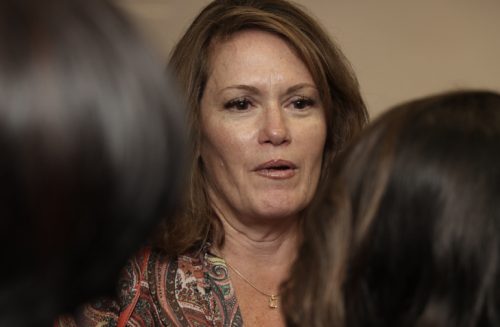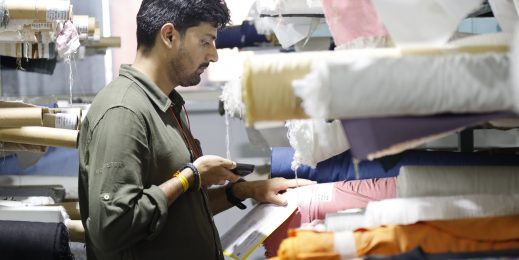
Peggy Johnson on business models, start-ups and diversity at Microsoft
Photo caption: Ranjita Bhagwan, a Microsoft Researcher in conversation with Peggy Johnson, EVP of Business Development, Microsoft
In a tête-à-tête with Ranjita Bhagwan, a Microsoft Researcher, Peggy Johnson, EVP of Business Development at Microsoft, shares her thoughts and insights on the work her team does at Microsoft. She also touches upon the gender divide, why it is important to have a diverse workforce and how sometimes that is the reason for being able to develop the best products.
Question (Q): What does Business Development at Microsoft entail?
Peggy Johnson (PJ): Essentially, we are all about growth for the company. And growth can be organic or inorganic, and we help on both sides. We probably concentrate more on the inorganic side, which usually comprises three different things—Partnerships that might put Microsoft into a new market. Acquisitions that involve straight up buying of companies. We do due diligence on the acquisition, which is sort of the thesis behind on why we may need to do an acquisition. And lastly, one that is fairly new to Microsoft—early stage investment.
Q: How many early stage investments has Microsoft done, could you share some examples and what goes in to validating the decision to invest?
PJ: We are very disciplined in the companies we choose to invest in. We are focussed on three core ambitions, they are in areas like Artificial Intelligence, Business SAS, Cloud, Infrastructure, Data Analytics, Security, and a little bit across the board, but all related to our three core ambitions. In the past year-and-a-half, we have done about 34 investments, which is a lot. Going forward, we probably would not do that exact number, probably less than that. I think a comfortable number for me would be somewhere in the range of 20–25 investments per year.
One of the interesting ones that we have done is in a little company called Comfy. Essentially, they go into buildings and plug their sensors on existing HVAC systems, no matter how old the system. And these sensors allow employees in the building to manage the temperature in their area through an incredibly simple and interesting UI. One of the biggest complaints that employees have in some of these big stack buildings, multiple floors, is the temperature—it’s either too hot or too cold. You just go to the app and say that you are feeling too hot or too cold. And employee satisfaction goes way up when you allow them to be able to handle the temperature in their area.
Another company that we almost made an investment in but ended up buying is a company called Maluuba. It is Montreal-based company that is into machine reading comprehension. We met them at one of the demo days, and they just blew us away. They showed us a page of Harry Potter that they basically just ingested into their system, and it just doesn’t define the words that are on the page, it comprehends the words and then you could ask it intuitive questions that may not be possible if you were just running that through a translator, to understand the definition of the words.
Q: Which technologies are you currently focusing on for early stage investment?
PJ: We have a big focus on AI, so that will continue, Business SAS is another area, we are looking at a lot of things that augment our existing dynamics and others, these little tuck-in technologies that are of interest to us as they pop up. We are taking a close look at security—all types—end points, network security, ploughs security—we’re seeing a lot of interesting companies out of Israel. We’ve bought three companies there, we have made a number of investments, we have a great individual on the ground there, Mony Hassid, he runs Microsoft Ventures for us there.
Other technologies we are interested in are Cloud Infrastructure, Mixed Reality and even Gaming in general. We just bought this company BEAM interactive, and we’ve put a lot of development around it, and now launched it as Mixer. All across those are the different dimensions we are looking at—talent, acquisitions and investments in those areas.
Q: Can you share more on the agenda of your current India visit?
PJ: I am not only meeting with some of the bigger companies here like Flipkart but also some of the trending start-ups as well. This is to ensure that people know that we are interested, that we are going to be here often. We’re not just parachuting in, doing a deal, and then we’re out. We want to have a long term partnership with these companies. Also, we don’t want to miss any of these trending start-ups. We are looking forward to getting to know the start-up community here.
What has interested me so far, in particular, is in the area of productivity. I think, because India is a mobile-only market, in a lot of the segments interesting productivity companies are arising here.
RB: Twenty-four years at Qualcomm before the shift to Microsoft. Has that been a big change?
PJ: In some ways, yes. In other ways, no. The similar things are that both companies rode big waves in their industry. Qualcomm rode that smartphone wave and Microsoft rode the PC wave and all the software around that. But with Microsoft, as the business transformed around Microsoft, they did a good job of moving into the next wave—into Cloud, into AI, into Mixed Reality. Satya is so focused on growth. You can’t just sit on your roles. So many companies that did are still stuck there. Always stay ahead. That’s why I love my job because we’re always thinking about what the next big thing is.
‘When you’re struggling, and you think am I the only one who is struggling with this, there a good chance that you’re not!’
Q: We all know that, at least in India, when they hire, you see a lot of women coming in at the lower level who are fresh out of college. But with time, we see that number going down. So do you have any suggestions on how one can sustain more women at senior or mid-level management?
PJ: The one thing that helps is Women @Microsoft having groups where they can plug into and get questions answered on how you can navigate various issues at work. Going back to Qualcomm, we have an informal group that I had pulled together of women across the company, where we would get together informally, depend on each other, and ask each other questions and use each other as sounding boards. Don’t underestimate the power of that. It’s super helpful. When you’re struggling, and you think am I the only one who is struggling with this, there a good chance that you’re not! It’s good to know that others have gone through that and they help each other navigate things. These groups are super powerful and necessary.
 We need to continue to be supportive of each other. It is an interesting phenomenon, say we’re graduating 20% women engineers and 20% are coming in the door, but as we go up the ranks we don’t always hang on to that percentage. That’s where I’m most focused right now. The company is really looking at how do we retain women. How do we make it easier? And I think just understanding that people have kids, men and women, we’re all juggling things, we have elderly parents and Microsoft is really doing a good job of helping us with those aspects. We have a new eldercare that we just introduced so we have the ability to take some time off if we have a sick child or an elderly parent. I wish I had a little bit more of that when my kids were little, but I do think that will affect our members. If we have a company that is supportive as we do, then it will keep women here longer.
We need to continue to be supportive of each other. It is an interesting phenomenon, say we’re graduating 20% women engineers and 20% are coming in the door, but as we go up the ranks we don’t always hang on to that percentage. That’s where I’m most focused right now. The company is really looking at how do we retain women. How do we make it easier? And I think just understanding that people have kids, men and women, we’re all juggling things, we have elderly parents and Microsoft is really doing a good job of helping us with those aspects. We have a new eldercare that we just introduced so we have the ability to take some time off if we have a sick child or an elderly parent. I wish I had a little bit more of that when my kids were little, but I do think that will affect our members. If we have a company that is supportive as we do, then it will keep women here longer.
‘It just makes business sense to have a diverse team who is going to design the best product that will be used by the most people.’
Q: There is a widely held perception that women tend to be more conservative than men. How do you break that perception to ensure diversity and inclusion?
PJ: It’s interesting. In the housing industry in the US, people said if you were less risky perhaps the recession would not have happened. I don’t know if I would categorize it as women or men, but I do think you need both inputs. If you only have people who are conservative or you only have people who are not, you cannot make the case for diversity. I feel like the best teams have a mix of both and that’s so important when you are building a product. You want the person to say “should we really do that?” as well as the big thinker who says “I think we should do this”. You want a mix of both of those things.
For me, when we talk about diversity, it just goes back to the business impact. Obviously, it’s a good thing to do, and it’s a good standard to aspire to have diverse teams, making sure all voices are heard. But there’s actually a business reason to diversity as well. We want to have the balance of all these different ideas that brings the best outcomes. An example of that is the team we built with Microsoft Ventures. It is a super diverse team, and I wanted a super diverse team because if I had all people of one type, their networks are all going to be the same network, and that’s just the way it is. I knew I wasn’t going to have a big team, which is why the team that I had, had to have the widest reach. They had to have the signal coming in from all these different areas.
If you hire a team of folks just in Silicon Valley, all it will bring me is things in Silicon Valley, but there’s a lot of innovation happening in markets like Boston, in markets like Frankfurt, in markets like Tel Aviv, we got to make sure that we are getting signals from all of those places. So we built this diverse team that has already brought us 34 investments, from all sorts of areas that we might not have thought of if the team was from any one area. You want make sure that you are touching as broad a network as you can.
And I just think the same could be said for design teams as we’re designing products. It just makes business sense to have a diverse team who is going to design the best product that will be used by most people. And when we translate it that way, people tend to be more on board with it. Otherwise, it’s easy to fall into the “oh it’s hard to find all sorts of different people for my team, it takes longer”. You need to put the time in because you’re going to have more of an impact. You’re going to make a better product at the end of the day.
As executive vice president of business development, Peggy Johnson is responsible for driving strategic partnerships and transactions to accelerate growth for Microsoft and its customers. Johnson works with external partners around the world, ranging from start-ups to large-scale enterprises, to identify areas of collaboration, drive innovation and unlock shared value. In this capacity, she also manages Microsoft’s relationship with the venture capital community and oversees strategic investments through the company’s corporate venture fund, Microsoft Ventures.
Ranjita Bhagwan is a researcher at Microsoft Research India. Previously, she was a research staff member at IBM T. J. Watson Research in Hawthorne, NY, USA. Prior to that, she completed her PhD in 2004 from the University of California at San Diego. Her interests are mainly in solving problems related to Networking and Distributed Systems.















